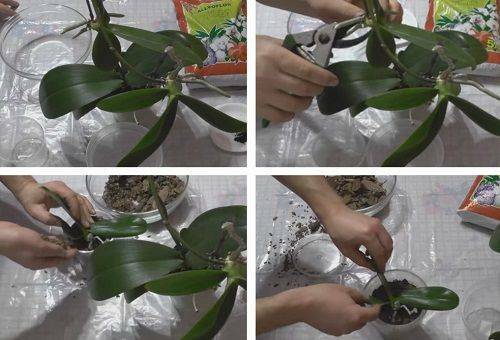Content:
- How to correctly adapt the flower after purchase?
- Creating optimal conditions for orchid development: lighting, temperature, watering, top dressing
- Techniques and peculiarities of reproduction of indoor orchids
- How to properly care for the plant during flowering and after it?
- Common diseases and pests of flowers
Unique flowering of orchids of various species is admirable, but only plant breeders themselves know what forces give such results, especially at home. A full-fledged care for a flower is not only the creation of an optimal environment home and the qualitative performance of systematic manipulations.

It is necessary to properly adapt the plant after arriving from the store, to prevent common diseases, to transplant the flower in time if necessary. Successful cultivation of orchids at home is based on a long list of nuances and features that can scare novice gardeners. Everything will turn out to be at its best, only if you follow the basic recommendations of professionals and listen to the advice of experienced masters of moody colors.
How to properly adapt the flower after purchase?
Few people are engaged in orchids, growing them from the seed, most often the flower appears in the apartment after a purchase in the profile store. In this case, it is necessary to ignore the basic rules of specific care, until the plant adapts under the new conditions. Particular attention should be paid to the following points:
- For two weeks, the room beauty should be in quarantine. It is better to arrange it separately from the rest of the plantings, on an individual window sill or bedside table.
- The time of quarantine is accompanied by protection against direct sunlight.
- From top dressing, persistently offered by shop sellers, it is also better to refuse for this period.
- Watering the first time is also not required.

Within two weeks after the purchase, one only needs to observe the leaves and roots of the plant, to check whether pests or signs indicating disease have appeared on them. At the end of the term, you can begin to water a little seedling and gradually accustom it to the sun's rays. A transplant immediately after the purchase is not required, in a good pot the flower will live without problems for another couple of years. Manipulation is carried out only if the orchid is planted in sphagnum.
Creation of optimal conditions for the development of orchids: lighting, temperature, watering, fertilizing
All kinds of plants are characterized by a whimsical attitude towards the environment. Therefore, the proper care for them begins with the provision of suitable conditions.
Requirements for lighting and its features:
- The fundamental factor responsible for the flowering of orchids, its health. It depends on it even the reproduction of the plant, its size and appearance. Only with a sufficient amount of light can we expect that growing the sample will give the desired result.
Tip: Some varieties of orchids, for example, Wanda, are so demanding of light and high humidity that, under improper conditions, rapidly lose the decorative appeal caused by leaves and flowers. Noticing such signals can quickly make adjustments to care, warning of possible diseases.
- Direct sunlight is prohibited, light should be abundant, but scattered. To create a shadow, we recommend using a matte film or opaque plastic.
- Autumn and winter from the creation of a shadow can be discarded. At this time, special attention will have to be paid to the length of daylight hours. If it is 10 hours or less, an artificial light source should appear in the home.
To the temperature regime of orchids are also very specific requirements. All kinds of these plants can be divided into three groups:
- Love the warmth. This includes Dendrobium, Phalaenopsis, Cattleya( some varieties).The extreme figures for the summer daytime period are 15-32 ° C.In winter, even at night, the data should not exceed 15-18 ° C.For a day at home or in a particular room, temperature differences within three degrees are allowed.
- Adherents of average temperatures. The brightest representative of the group is Miltonia. She prefers cooler conditions. In summer, the temperature should be kept within 18-22 ° C, in winter at home it will be enough 12-15 ° C.
- Love the coolness. This group includes Cumbria, Dendrobium Nobile, many Lelia. In summer, the optimum temperature is 22 ° C, in winter - within 12-15 ° C.

Watering is another important point in the care of orchids. In nature, the roots of most varieties do not tolerate moisture stagnation, so they are not in the water. This explains the fact that growing in conditions of increased dryness for flowers is preferable to excessive watering. At the same time, one should not forget that some plant species are excessively demanding for this indicator:
- Oncidium and Dendrobium prefer dry substrates, they should be watered only after the earthen coma has completely dried in the pot.
- Phalaenopsis and Paphiopedialium prefer moist soil, but only if after the purchase it took at least two weeks and the flower completely adapted in the atmosphere of the new house.
- During active growth, flowering, release of peduncles, watering should be increased.
Tip: To assess the quality of care for beginners, namely, the adequacy of watering, you can simply by visual assessment of orchids. If something starts to happen with the leaves, and they wrinkle, and the pseudobulbs begin to dry up, this will be a sign of a lack of moisture. Decaying roots in combination with yellowing leaves indicate an overabundance of water.
In winter and during the rest period after flowering, the abundance of watering should be reduced. In conditions of coolness and lack of light, a room orchid will not need a lot of moisture. The rules for watering a capricious plant require the use of soft water. It can be settled for two days, thawed, boiled.
The watering has its own characteristics and can be carried out in two ways. In the first case, which is preferable for beginners, we put the plant directly in the pot in a container with prepared and slightly warm water. In the second, a plentiful shower is used. After manipulation, the flower should be held on a grate to allow excess water to flow out, otherwise the roots will rot.
The correct approach to the introduction of fertilizers raises many questions among beginners and experienced connoisseurs of orchids. In this case it is recommended to study the advice of specialists for each specific species, but you should not forget about the basic rules:
- At home, the introduction of fertilizing should be done only during growth.
- Products need to be selected special, using them strictly according to the instructions not more than once in 2-3 weeks.
- In winter, top dressing of flowers is strictly forbidden! This rule applies to all types and varieties of plants.
- High concentration of mineral salts in the soil provokes diseases, for this reason, during the period of top dressing, it is necessary to wash the soil with warm water.
If you keep the plant at home, it is better not to use fertilizers at all, confining yourself to replacing the soil every two years, at the time the transplant is performed. An exception is a room dwarf orchid. On the contrary it is recommended to feed it up sometimes, adding mineral compounds directly to the water when its specific watering is performed.
Given the specifics of the growth of flowers in natural conditions, it is better not to mix the soil for them on their own, but to buy them in ready-made form. For example, Cymbidium needs a heavy and moist substrate, which many other species do not accept.
Techniques and peculiarities of reproduction of indoor orchids
If all the features of flower care at home are studied and no longer present any problems, then the reproduction of the plant will not cause difficulties. There are several approaches that the newcomer can easily handle:

- With stem siblings. A similar process may appear on the plant with an elevated nitrogen content in it. If you find such an education, you need to spray the flower more often and wait until the roots appear in the branch. Then we separate the young specimen, treat it with charcoal and plant it separately. Such reproduction is possible in any season.
- Layering. In plants with cylindrical or elongated shoots, an air process may appear. In this case, part of the stem must be bent and above it put a plastic greenhouse with a slot. Continuing to water the flower, especially its roots, we await the awakening of the sleeping buds. When they wake up, we continue moistening until the moment of rooting. Only after this, it is possible to reproduce the plant - it must be separated from the mother's shoot and transplanted into a separate pot.
- The roots. The simplest version of the approach at home, but you can use it only after reaching the flower of impressive size. We take the plant out of the pot, clean the roots of the soil, cut it with garden scissors, leaving at least three pseudobulbs on each part. Cut the slice with charcoal and arrange the samples for different capacities. Reproduction is over, you just need to regularly water new plants.
- Seeds. Quite a troublesome and complex process, the rules of conducting which depend on the plant variety.
In addition, some orchids multiply by leaves, but with this approach, the roots of the desired mass and density do not always appear, which often leads to the death of the plant.
How to properly care for the plant during flowering and after it?
If the orchid grows at home with all the conditions, it will blossom regularly. Care of the flower in this case implies several features:
- Watering should be more frequent and abundant, but do not forget to get rid of excess water so that there are no problems with the roots.
- We raise the night temperature by at least five degrees.
- A transplant is prohibited at this time, otherwise the flowers and buds will fall off.
- Top dressing is acceptable and even desirable, but only in a limited amount.
- After flowering, pruning is carried out. Simultaneously, the conditions of care return to the traditional.
If the orchid is covered with shriveled, yellowed leaves and does not release the flower spike, it should be moved to another place, and in the last resort, a transplant.

Common diseases and pests of flowers
Fortunately, diseases and pests affect demanding flowers not often. Usually this happens if the care tips are not followed or the house is not provided with the appropriate conditions:
- Leaf flabbiness. Occurs as a result of root damage or a violation of temperature conditions.
- Cracks in the center of the sheet. The consequences of not only mechanical damage, but also a sharp temperature drop.
- Appearance on the leaves of black spots, outgrowths, cones, holes. Result of exposure to direct sunlight.
- Silvery spider web on the underside of the leaves. Defeat by a spider mite. These pests can be eliminated only with the help of special preparations.
- Drying and decay of leaves. Consequences of the life of soft-bitten mites. Most often they are located in the center of the outlets. To eliminate them, you will also have to use specialized chemicals.
- Slow growth, refusal of flowering. May be the result of the appearance of nematodes sucking juice out of the plant. Removed nematicides, you need to act strictly according to the instructions.
Accurate observance of the recommendations allows to count on regular and magnificent flowering of the selected orchid variety. Some varieties can bloom even in winter, if correctly brought them to the process and provide a qualitative period of rest.
Read the article on how to care for an anthurium



